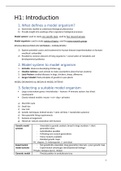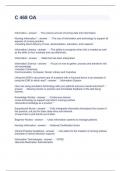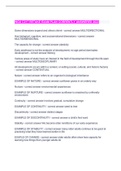H1: Introduction
1. What defines a model organism?
a) Extensively studied to understand biological phenomena
b) Provide insight into workings other organisms/ biological processes
Model system= used to study very specific topic, used by few research groups
Model organism= used to study variety of topics, used by many research groups
ETHICAL REGULATIONS ON VERTEBRAE + CEPHALOPODS!
1) Explore potential causes and treatments for human disease (experimentation on humans
unethical/ unfeasible)
2) Possible by common descent of living organisms + conservation of metabolic and
developmental pathways
2. Model system to model organism
1. Aristotle: observes developing chicken egg
2. Claudius Galenus: used animals to make assumptions about human anatomy
3. Louis Pasteur: studied diseases in dogs, chickens, sheep, silkworms
4. Gregor Mendel: finds principles of genetics in pea plants
MODEL ORGANISMS ALL BEGAN AS MODEL SYSTEMS!
3. Selecting a suitable model organism
Large conservation genes: invertebrates – humans immune system: less direct
counterparts
Closely related models: mouse + rat + dog + primates
a) Short life-cycle
b) Small size
c) Low cost
d) Genetic techniques (inbred strains + stem cell lines + transfection systems)
e) Non-specialist living requirements
f) Genome arrangement
g) Historical/ natural association with humans
Genetic model - Amenable to genetic analysis: breed in large numbers + short
systems generation time
- Hybridisation possible
- Following over several generations
- Many mutants available
- Detailed genetic maps
C. elegans, D. melanogaster, S. cerevisiae
Experimental - Not genetically amenable: long generation intervals + poor genetic map
model systems - Experimental advantages (developmental biology)
Hydra, Xenopus laevis, chicken
Genomic model - Pivotal position in evolutionary tree
1
, systems - Genome ideal for study
tardigrade, puffer fish
4. Homology and synteny
Homology= similarity in structures due to common descent insulin genes in mice and humans
Paralogs= two homologous genes that are product of gene duplication humans with several
hemoglobin genes
Orthologs= two homologous genes that are product of speciation human and mice insulin
Synteny= finding genes in comparable places (conserved positions throughout evolution)
5. Comparative genomics
a) Understand evolution
b) Improve crops
c) Identify genetic basis of disease
GENETIC INFO IS EXCHANGEABLE: MANY GENES ARE CONSERVED OVER ORGANISMS
GENOME SIZE IS UNRELATED TO COMPLEXITY!
EPIGENETICS + GENE EXPRESSION + ALTERNATIVE SPLICING DETERMINES ORGANISM
Gene expression:
1. Single mutation in FOXP2 gene impairs speech but not language comprehension
2. FOXP2 found in primates + mice 2-3 AA differences
3. Difference allowed speech to arise
Small changes can affect function
Diverse lifeforms can emerge from similar toolkits of genes
6. Genome evolution
Autopolyploidy= genome of one species duplicated
Allopolyploidy= hybridization + duplication of genomes of two different species more copies of
chromosome, bigger organisms
Release of selection pressure: novel functions + get lost + pseudogene + function partitions
into two duplicates
MANIPULATE MORE DNA IN MODEL ORGANISMS
5% OF HUMAN GENOME CONSISTS OF SEGMENTAL DUPLICATIONS, GENES HAVE DIFFERENT
EXPRESSION PATTERNS
Horizontal gene transfer= genes hitchhike from other species, organisms swap genes (bacteria,
viruses, formation eukaryotes, immune system)
MODEL ORGANISMS DO NOT HAVE FINAL/ OPTIMIZED GENOMES
a) What question needs to be answered?
b) Which organism can help solving this question?
2
, c) What are the possibilities and practical constraints?
d) What are ethical concerns?
7. Browsing through model organisms
Earth belongs to prokaryotes
Life on earth is > 3.4 billion years old (Cyanobacteria)
1) Prokaryotes
2) Protista
3) Plants
4) Fungi
5) Invertebrates
6) Vertebrates (fish, birds, amphibians, rodents, dog, monkey)
7) Cell lines
Non-model organisms= drug discovery + evolutionary gap
Difficult to breed in captivity
Collected in the wild
Genome, transcriptome, proteome information and tools often missing
On the other hand, an observation made in one model is often relevant to other models: enhance
interactions between model systems
Complete genome sequences has greatly facilitated comparisons between different species and
increased interactions among research communities
Neurospora crassa - Clean genetics
- Gene-enzyme relationships
- Circadian rhythm
- Epigenetic gene silencing
E. coli - Gene regulation studies
Mycoplasma sp. - Minimal genome that can sustain life
Bacillus subtilis - Gram-positive bacteria
- Sporulation, resistance and biofilms
Caulobacter - Cell differentiation
crecentus - Decision making between stalked cell and swimming
Dictyostelium - Sporulation, resistance and biofilms
discoideum
C. elegans
D. melanogaster
H2: Yeast
Saccharomyces cerevisiae Schizosaccharomyces pombe
Budding yeast Fission yeast: grow on ends, divide in middle
- Cell cycle, DNA repair and genetics - Cell cycle, DNA damage responses &
- Signal transduction genetics
- Protein interaction/aggregation - Subcellular localization & trafficking
- Ageing & disease - RNAi possible
NO INTRONS easy for research Structure DNA similar to humans
3
, Genome: 1996 Genome: 2002
Study human disease homologs Study human disease homologs
1. S. cerevisiae
Ancestor: 1 billion years ago evolutionary distance: 2 billion years
Unicellular eukaryote
Advantages:
1) Small size
2) Rapid growth (doubles every 1-2h)
3) Small genome
4) Amenable for genetics: short life cycle + HIGH RECOMBINATION FREQUENCY + easy
transformation + tetrad analysis
Yeast genome:
12.5 Mbp in 16 chromosomes
4% have introns few alternative splicing
Average gene is ~1700 bp
Many genes contain ORF, not all (some genes don’t code for protein)
1 cM=2.8 kb average (700 kb in humans)
Morgan= unit of chromosomal distance between 2 genes/ recombination frequency/ percentage of
homologous recombination important to know whether double mutants can be made
0 M: no recombination, 100M: always recombination
THE SMALLER cM, THE MORE RECOMBINATION OCCURS!
2. Life cycle
S. cerevisiae (N=16)
Only mate with other mating type: a and α
Spores together in ascus product of single
meiotic division together (genetics traceable)
S. pombe (N=3)
Mating types (+ and -) mate when starved
Production ascospores
Choices: divide/not + haploid/diploid + mating and meiosis
Difference: preferred mode of growth + division
1. Haploids divide mitotically generate stable colony
2. Mat A gene drives A program in cell + 2 α loci on mat α gene drive α program
3. Opposite mating type mates diploid with A and α gene (no feromones + receptors)
4. Mitosis stable colony
5. Diploids enter meiosis + sporulate producing tetrads
4






